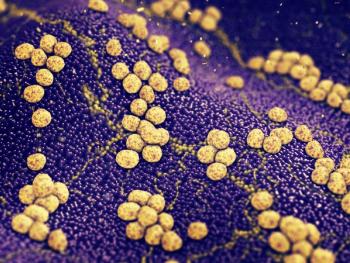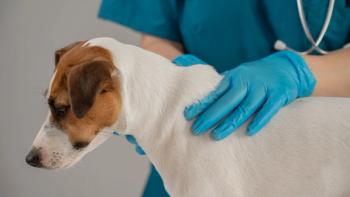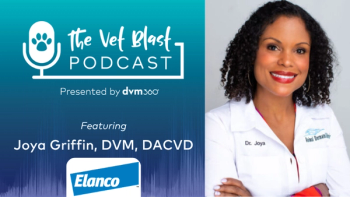
Feline dermatology (Proceedings)
There is more to know than Depomedrol!!!
There is more to know than Depomedrol!!!
Feline Integument
1. Unique Skin-Thinnest skin of all domestic animals.
2. Primary and secondary hairs ratio (1:10-24).
3. pH-5.6-7.4.
Eosinophilic Granuloma Complex
Group of inflammatory lesions affecting skin, mucocutaneous junctions and oral cavity of cats, usually due to genetic, parasitic, allergic, foreign body, viral and/or bacterial causes.
It is a syndrome, not a diagnosis.
Three variants of eosinophilic granuloma complex:
1. Indolent ulcer
2. Eosinophilic plaque
3. Eosinophilic granuloma
Indolent Ulcer
Ulcerated lesion of upper lip.
Alopecia, raised border.
Blood and tissue eosinophilia is rare.
Eosinophilc Plaque
Moist alopecic papules and plaques.
Usually abdomen but maybe on neck.
Severe pruritus is usally associated.
Blood and tissue eosinophilia.
Eosinophilic Granuloma
Pink to yellow raised plaque which maybe linear.
Usually on caudal thigh of young cats.
Nonpruritic.
Younger and female cats predisposed.
Focal collagen degeneration.
Chin edema
EGC Pathogensesis
Genetic.
Allergic.
This is most common underlying cause.
Atopy, food allergy, mosquitoes.
Parasitic.
Bacterial.
Foreign body.
Diagnosis
Clinical signs
Histopathology
Cytology
EGC Treatment
Depomedrol: every 2- weeks for 3 treatments.
Antibiotics, especially Ditrim 120mg or Clavamox.
Alpha-interferon 30-60 U PO/day, 7 days on, 7 days off.
Intradermal allergy test- Allergy vaccine therapy.
Oral Prednisone tapered to every other day.
CO2 laser surgery.
Antihistamines? Usually ineffective
Cyclosporine therapy- 5mg/kg every day for 4-6 weeks, then every other day.
Gold salt therapies.
Feline Acne
Alopecia, comedones, and follicular casts and crusts.
Rule out allergies, contact irritant reactions.
Pathogenesis
Folliculitis.
Demodex, Dermatophytes, Malassezia, Staphylococcus
Keratinization defect.
Allergies.
Atopy, food intolerance, contact
Diagnosis
Thorough history- include type of food/water bowls (avoid plastic
Cytology
Skin scrapings
Dermatopathology
Acne Treatment
Cleansing
Antibiotics
Lymdyp?
Miconazole shampoos
Corticosteroids
Atopy
Seasonal to nonseasonal pruritus associated with elevated IgE.
Clinical signs include miliary dermatitis, alopecia, otitis externa, facial and cervical pruritus.
No age or breed predisposition.
Often misdiagnosed as Psychogenic alopecia??
Diagnosis
Thorough history.
Skin scrapings.
Intradermal allergy tests:often difficult to read in the cat
Serologic allergy testing??-unreliable
Treatment
Immunotherapy:75-80 have good to excellent response.
Antihistamines.
Chlorpheniramine 2-4 mg/bid
Claritin ?
Fatty acids.
GCC
Depomedrol?
Prednisone.
Adverse Reactions to Food
Nonseasonal pruritus
Usually beef, lamb, fish, milk.
Nonimmunologic based intolerance related to elevated histamines in certain fish.
Steroid responsive??
No age sex or breed predilection.
Clinical Signs
Clinical signs include miliary dermatitis, alopecia, otitis externa, facial and cervical pruritus may be prominent.
Diagnosis
Dietary trials for 8-10 weeks with Eukanuba LB, Z/D, IVD diets, Home cooked often difficult.
Serology testing and Intradermal allergy testing are not reliable.
Demodicosis
Excessive proliferation of 2 species of demodex, D. cati and D. gatoi.
FeLV, FIV, DM may predispose to D. cati.
Variable pruritus but usually much more pronounced with D. gatoi.
Diagnosis
Diagnosis with skin scrapings.
Treatment
Lymdyps every 5 days for D. cati, and D. gatoi.
Pemphigus Foliaceus
Most common AISD
Pemphigus is Greek for "blister"
Acanthloysis:Keratinocytes lose their cellular attachments
Intraepidermal clefts are formed.
Neutrophils invade vesicle leading to pustule formation
Clinical Signs
Facial crusts, ulcers
Large intact pustules??
Footpad hyperkeratosis, ulcers
Fevers, Anorexia
Laboratory Signs
Leukocytosis with neutrophilia and left shift
Nonregenerative anemia
Dermatopathology: Intraepidermal pustule with acantholysis
and neutrophils or eosinophils
Cytology:Tzanck Prep: Hypersegmented neutrophils, no intracellular bacteria, acantholytic cells
Treatment
Corticosteroids 2-4 mg/kg
Imuran Do not use in cats
Leukeran 0.1-0.2 mg/kg
Aurothioglucose 1mg/kg weekly for 12 weeks(difficult to obtain)
Paraneoplastic Alopecia
Rare syndrome, seen in older cats
Pancreatic carcinoma
Weight loss, anorexia
"Shiny skin" is seen
Exfoliative alopecia
Diagnosis
Dermatopathology is suggestive to diagnostic
Treatment
Grave prognosis
Supportive therapies
Newsletter
From exam room tips to practice management insights, get trusted veterinary news delivered straight to your inbox—subscribe to dvm360.




